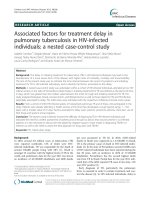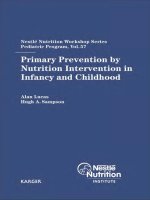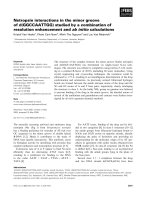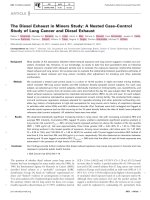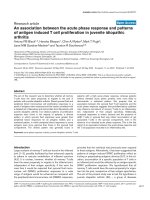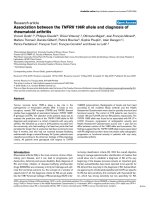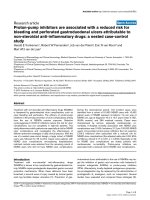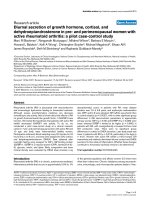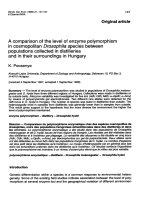Association between parent-infant interactions in infancy and disruptive behaviour disorders at age seven: A nested, case–control ALSPAC study
Bạn đang xem bản rút gọn của tài liệu. Xem và tải ngay bản đầy đủ của tài liệu tại đây (366.47 KB, 8 trang )
Puckering et al. BMC Pediatrics 2014, 14:223
/>
RESEARCH ARTICLE
Open Access
Association between parent-infant interactions in
infancy and disruptive behaviour disorders at age
seven: a nested, case–control ALSPAC study
Christine Puckering1, Clare S Allely2, Orla Doolin3, David Purves3, Alex McConnachie3*, Paul CD Johnson3,
Helen Marwick4, Jon Heron5, Jean Golding6, Christopher Gillberg1 and Philip Wilson7
Abstract
Background: Effective early intervention to prevent oppositional/conduct disorders requires early identification
of children at risk. Patterns of parent-child interaction may predict oppositional/conduct disorders but large
community-based prospective studies are needed to evaluate this possibility.
Methods: We sought to examine whether the Mellow Parenting Observational System (MPOS) used to assess
parent-infant interactions at one year was associated with psychopathology at age 7. The MPOS assesses positive
and negative interactions between parent and child. It examines six dimensions: anticipation of child’s needs,
responsiveness, autonomy, cooperation, containment of child distress, and control/conflict; these are summed to
produce measures of total positive and negative interactions. We examined videos from the Avon Longitudinal
Study of Parents and Children (ALSPAC) sub-cohort who attended the ‘Children in Focus’ clinic at one year of age.
Our sample comprised 180 videos of parent-infant interaction: 60 from infants who received a psychiatric diagnostic
categorisation at seven years and 120 randomly selected controls who were group-matched on sex.
Results: A negative association between positive interactions and oppositional/conduct disorders was found. With
the exception of pervasive developmental disorders (autism), an increase of one positive interaction per minute
predicted a 15% (95% CI: 4% to 26%) reduction in the odds of the infant being case diagnosed. There was no
statistically significant relationship between negative parenting interactions and oppositional/conduct disorders,
although negative interactions were rarely observed in this setting.
Conclusions: The Mellow Parenting Observation System, specifically low scores for positive parenting interactions
(such as Responsiveness which encompasses parental warmth towards the infant), predicted later psychiatric
diagnostic categorisation of oppositional/conduct disorders.
Keywords: ALSPAC, Disruptive behaviour disorders, Parent-infant interactions, Mellow Parenting Observation
System
Background
Conduct disorder (CD), oppositional-defiant disorder
(ODD), disruptive behaviour disorder NOS (DBD-NOS)
and Attention-Deficit/Hyperactivity Disorder (ADHD)
grouped together here as disruptive behaviour disorders,
are characterised by a set of externalising disruptive behaviours that occur during childhood. ODD involves
* Correspondence:
3
Robertson Centre for Biostatistics, University of Glasgow, Boyd Orr Building,
Glasgow, Scotland G12 8QQ, UK
Full list of author information is available at the end of the article
repeated negativistic, defiant, disobedient and hostile behaviour toward authority figures. ADHD is characterised
by developmentally inappropriate inattention, motor activity and impulsive behaviours which cause impairments in
both social and academic functioning. ADHD is a chronic
debilitating condition associated with significant costs to
patients, families as well as society, specifically social and
health care services [1]. CD involves a number of problematic behaviours including oppositional and defiant behaviours and antisocial activities (e.g., lying, stealing,
running away and physical violence).
© 2014 Puckering et al.; licensee BioMed Central Ltd. This is an Open Access article distributed under the terms of the Creative
Commons Attribution License ( which permits unrestricted use, distribution, and
reproduction in any medium, provided the original work is properly credited. The Creative Commons Public Domain
Dedication waiver ( applies to the data made available in this article,
unless otherwise stated.
Puckering et al. BMC Pediatrics 2014, 14:223
/>
CD has substantial health and social costs and there is
an increasingly strong case for screening in early childhood [2]. Without intervention, levels of physical and
psychiatric mortality and morbidity are high [3]. In an
offender cohort followed up between 1st January 1988 to
31st December 1999, young males were nine times more
likely and females 40 times more likely to die compared
to young people in the general population [3]. CD is
also associated with increased risk of criminality [4].
Early intervention with parents can prevent its development [5] and treatment in early childhood is relatively
successful [6], while less success is found with adolescents [7]. About 40% of children with CD will go on to
develop antisocial personality disorder [8]. Prediction of
risk on the basis of demographic information is unlikely
to be sufficiently sensitive or specific [9] and so observational assessment of social interactions, whether by parents or independent observers, may prove useful in
early identification.
There is a substantial body of work investigating negative aspects of parenting. For example, low maternal responsiveness during the first year of life is associated
with later onset of child disruptive behaviours [10,11].
During the infant’s first year, exposure to maternal depression has been found to be related to reports of child
internalising and externalising problems by the mother
in the early school years (6-8 years) [12]. Positive aspects
of parenting, such as warmth, positive involvement and
secure child-parent attachment may independently affect
the risk of developing disruptive behaviour disorders
[13,14]. Lower levels of externalising behaviour in childhood have been found in those children of mothers who
displayed significantly higher levels of positive parenting
throughout toddlerhood [15].
Given the evidence for the benefit of early interventions, primary care clinicians might benefit from the
availability of measures which could assist in the prediction of developmental disorders. The present study,
based on a large cohort of infants from the Avon Longitudinal Study of Parents and Children (ALSPAC), investigated whether assessment of parenting behaviours at
one year can predict psychopathology at age seven. We
examined the utility of both positive and negative parenting behaviours towards infants in predicting the later
onset of psychopathologies.
Methods
Participants
The sample comprised participants from the Avon Longitudinal Study of Parents and Children (ALSPAC). ALSPAC
is an ongoing population-based study investigating a wide
range of environmental and other influences on the health
and development of children. Pregnant women resident in
the former Avon Health Authority in south-west England,
Page 2 of 8
having an estimated date of delivery between 1 April 1991
and 31 December 1992 were invited to take part, resulting
in a ‘core’ cohort of 13,988 singletons/twins alive at 12
months of age [16]. The study website contains details of
all the data that are available through a fully searchable
data dictionary ( />data-access/data-dictionary/).
Ethical approval for the study was obtained from the
ALSPAC Law and Ethics Committee and the Local Research Ethics Committees. All adult participants gave
their informed consent prior to their inclusion in the
study. A 10% sample of the ALSPAC cohort, known as
the Children in Focus (CiF) group, attended clinics at
the University of Bristol at various time intervals between 4 to 61 months of age. For the current study a
sample was drawn from this sub sample of the core
ALSPAC cohort of 1240 families (usually mother/infant
dyads) who attended the ‘Children in Focus’ clinics when
children were 12 months old. A range of measures was
collected at the clinic including anthro����������������������������������������������������������������������������������������������������������������������������������������������������������������������������������������������������������������������������������������������������������������������������������������������������������������������������������������������������������������������������������������������������������������������������������������������������������������������������������������������������������������������������������������������������������������������������������������������������������������������������������������������������������������������������������������������������������������������������������������������������������������������������������������������������������������������������������������������������������������������������������������������������������������������������������������������������������������������������������������������������������������������������������������������������������������������������������������������������������������������������������������������������������������������������������������������������������������������������������������������������������������������������������������������������������������������������������������������������������������������������������������������������������������������������������������������������������������������������������������������������������������������������������������������������������������������������������������������������������������������������������������������������������������������������������������������������������������������������������������������������������������������������������������������������������������������������������������������������������������������������������������������������������������������������������������������������������������������������������������������������������������������������������������������������������������������������������������������������������������������������������������������������������������������������������������������������������������������������������������������������������������������������������������������������������������������������������������������������������������������������������������������������������������������������������������������������������������������������������������������������������������������������������������������������������������������������������������������������������������������������������������������������������������������������������������������������������������������������������������������������������������������������������������������������������������������������������������������������������������������������������������������������������������������������������������������������������������������������������������������������������������������������������������������������������������������������������������������������������������������������������������������������������������������������������������������������������������������������������������������������������������������������������������������������������������������������������������������������������������������������������������������������������������������������������������������������������������������������������������������������������������������������������������������������������������������������������������������������������������������������������������������������������������������������������������������������������������������������������������������������������������������������������������������������������������������������������������������������������������������������������������������������������������������������������������������������������������������������������������������������������������������������������������������������������������������������������������������������������������������������������������������������������������������������������������������������������������������������������������������������������������������������������������������������������������������������������������������������������������������������������������������������������������������������������������������������������������������������������������������������������������������������������������������������������������������������������������������������������������������������������������������������������������������������������������������������������������������������������������������������������������������������������������������������������������������������������������������������������������������������������������������������������������������������������������������������������������������������������������������������������������������������������������������������������������������������������������������������������������������������������������������������������������������������������������������������������������������������������������������������������������������������������������������������������������������������������������������������������������������������������������������������������������������������������������������������������������������������������������������������������������������������������������������������������������������������������������������������������������������������������������������������������������������������������������������������������������������������������������������������������������������������������������������������������������������������������������������������������������������������������������������������������������������������������������������������������������������������������������������������������������������������������������������������������������������������������������������������������������������������������������������������������������������������������������������������������������������������������������������������������������������������������������������������������������������������������������������������������������������������������������������������������������������������������������������������������������������������������������������������������������������������������������������������������������������������������������������������������������������������������������������������������������������������������������������������������������������������������������������������������������������������������������������������������������������������������������������������������������������������������������������������������������������������������������������������������������������������������������������������������������������������������������������������������������������������������������������������������������������������������������������������������������������������������������������������������������������������������������������������������������������������������������������������������������������������������������������������������������������������������������������������������������������������������������������������������������������������������������������������������������������������������������������������������������������������������������������������������������������������������������������������������������������������������������������������������������������������������������������������������������������������������������������������������������������������������������������������������������������������������������������������������������������������������������������������������������������������������������������������������������������������������������������������������������������������������������������������������������������������������������������������������������������������������������������������������������������������������������������������������������������������������������������������������������������������������������������������������������������������������������������������������������������������������������������������������������������������������������������������������������������������������������������������������������������������������������������������������������������������������������������������������������������������������������������������������������������������������������������������������������������������������������������������������������������������������������������������������������������������������������������������������������������������������������������������������������������������������������������������������������������������������������������������������������������������������������������������������������������������������������������������������������������������������������������������������������������������������������������������������������������������������������������������������������������������������������������������������������������������������������������������������������������������������������������������������������������������������������������������������������������������������������������������������������������������������������������������������������������������������������������������������������������������������������������������������������������������������������������������������������������������������������������������������������������������������������������������������������������������������������������������������������������������������������������������������������������������������������������������������������������������������������������������������������������������������������������������������������������������������������������������������������������������������������������������������������������������������������������������������������������������������������������������������������������������������������������������������������������������������������������������������������������������������������������������������������������������������������������������������������������������������������������������������������������������������������������������������������������������������������������������������������������������������������������������������������������������������������������������������������������������������������������������������������������������������������������������������������������������������������������������������������������������������������������������������������������������������������������������������������������������������������������������������������������������������������������������������������������������������������������������������������������������������������������������������������������������������������������������������������������������������������������������������������������������������������������������������������������������������������������������������������������������������������������������������������������������������������������������������������������������������������������������������������������������������������������������������������������������������������������������������������������������������������������������������������������������������������������������������������������������������������������������������������������������������������������������������������������������������������������������������������������������������������������������������������������������������������������������������������������������������������������������������������������������������������������������������������������������������������������������������������������������������������������������������������������������������������������������������������������������������������������������������������������������������������������������������������������������������������������������������������������������������������������������������������������������������������������������������������������������������������������������������������������������������������������������������������������������������������������������������������������������������������������������������������������������������������������������������������������������������������������������������������������������������������������������������������������������������������������������������������������������������������������������������������������������������������������������������������������������������������������������������������������������������������������������������������������������������������������������������������������������������������������������������������������������������������������������������������������������������������������������������������������������������������������������������������������������������������������������������������������������������������������������������������������������������������������������������������������������������������������������������������������������������������������������������������������������������������������������������������������������������������������������������������������������������������������������������������������������������������������������������������������������������������������������������������������������������������������������������������������������������������������������������������������������������������������������������������������������������������������������������������������������������������������������������������������������������������������������������������������������������������������������������������������������������������������������������������������������������������������������������������������������������������������������������������������������������������������������������������������������������������������������������������������������������������������������������������������������������������������������������������������������������������������������������������������������������������������������������������������������������������������������������������������������������������������������������������������������������������������������������������������������������������������������������������������������������������������������������������������������������������������������������������������������������������������������������������������������������������������������������������������������������������������������������������������������������������������������������������������������������������������������������������������������������������������������������������������������������������������������������������������������������������������������������������������������������������������������������������������������������������������������������������������������������������������������������������������������������������������������������������������������������������������������������������������������������������������������������������������������������������������������������������������������������������������������������������������������������������������������������������������������������������������������������������������������������������������������������������������������������������������������������������������������������������������������������������������������������������������������������������������������������������������������������������������������������������������������������������������������������������������������������������������������������������������������������������������������������������������������������������������������������������������������������������������������������������������������������������������������������������������������������������������������������������������������������������������������������������������������������������������������������������������������������������������������������������������������������������������������������������������������������������������������������������������������������������������������������������������������������������������������������������������������������������������������������������������������������������������������������������������������������������������������������������������������������������������������������������������������������������2
Mother age at birth (for 1 year increase)
29.5 (4.5)
0.90 (0.83, 0.97),
p = 0.004
1.02 (1.00, 1.04),
p = 0.033
Parity (per unit increase)
0.7 (0.8)
0.87 (0.56, 1.36), p = 0.550
0.97 (0.88, 1.08), p = 0.584
Maternal depression at 32–40 weeks (per unit
increase)
6.9 (5.0)
1.01 (0.94, 1.08), p = 0.812
1.01 (1.00, 1.03), p = 0.118
Postnatal depression at 8 months (per unit
increase)
5.6 (5.0)
1.03 (0.97, 1.10), p = 0.354
1.01 (0.99, 1.02), p = 0.478
Maternal anxiety at 32–40 weeks (per unit
increase)
4.7 (3.4)
1.03 (0.93, 1.14), p = 0.630
1.02 (0.99, 1.04), p = 0.153
Child gender
Postnatal anxiety at 8 months (per unit increase)
3.8 (3.9)
1.00 (0.92, 1.10), p = 0.934
1.01 (0.99, 1.04), p = 0.172
No
24 (15.1%)
-
-
Yes
135 (84.9%)
1.26 (0.47, 3.36), p = 0.649
1.19 (0.94, 1.51), p = 0.150
Never married
22 (13.8%)
-
-
123 (77.4%)
1.09 (0.40, 2.97), p = 0.873
1.27 (1.00, 1.63), p = 0.054
9 (5.7%)
1.03 (0.18, 5.82), p = 0.970
1.25 (0.82, 1.90), p = 0.292
Divorced
5 (3.1%)
0.66 (0.07, 6.16), p = 0.718
1.34 (0.80, 2.24), p = 0.264
No
14 (9.2%)
-
-
Yes
139 (90.8%)
0.50 (0.15, 1.63), p = 0.251
1.20 (0.89, 1.62), p = 0.225
Vocational/CSE/
GCSE
89 (56.0%)
-
-
A level/Degree
70 (44.0%)
1.02 (0.51, 2.04), p = 0.958
1.32 (1.12, 1.55),
p = 0.001
No
133 (88.7%)
-
-
Yes
17 (11.3%)
1.11 (0.36, 3.42), p = 0.861
0.89 (0.68, 1.16), p = 0.389
No
128 (81.0%)
-
-
Yes
30 (19.0%)
0.64 (0.26, 1.58), p = 0.331
0.91 (0.73, 1.13), p = 0.384
Alcohol during first trimester (glasses of alcohol
per week)
<1
129 (81.6%)
-
-
≥1
29 (18.4%)
1.04 (0.43, 2.52), p = 0.929
1.04 (0.84, 1.29), p = 0.737
Partner physically hurt mother at 18 weeks
gestation
No
143 (93.5%)
-
-
Yes
10 (6.5%)
1.29 (0.32, 5.17), p = 0.718
1.03 (0.72, 1.46), p = 0.880
No
152 (95.0%)
-
-
Yes
8 (5.0%)
0.34 (0.06, 1.97), p = 0.230
1.01 (0.69, 1.47), p = 0.962
Infant breast fed
st
Marital status
Father in household
Maternal education levels
Anyone with chronic illness in household
Smoked during first trimester
Partner physically hurt mother postnatally
1 marriage
2nd/3rd marriage
Social support score (per unit increase)
20.1 (4.8)
0.94 (0.87, 1.01), p = 0.072
1.01 (0.99, 1.03), p = 0.335
Life event score 18–23 weeks (per unit increase)
8.6 (6.5)
1.02 (0.97, 1.08), p = 0.417
1.00 (0.98, 1.01), p = 0.716
Maternal bonding score (per unit increase)
28.0 (4.0)
0.98 (0.91, 1.07), p = 0.723
0.98 (0.96, 1.00),
p = 0.024
Aggression score (per unit increase)
10.2 (1.8)
0.96 (0.78, 1.17), p = 0.655
1.03 (0.98, 1.08), p = 0.300
(Effect estimates are the relative change in interaction scores for a specified increase in continuous predictor variables or compared to the stated reference group
for categorical predictors).
*Mean (SD) presented for continuous variables and N (%) for categorical.
- indicates reference category in regression analysis.
Statistically significant associations (p<0.05) are highlighted in bold text.
behaviours was demonstrated by the ALSPAC participants. Furthermore, if videos were available of settings
specifically designed to elicit a range of positive and negative interactions, then this could enhance the reliability of
the MPOS measure. Finally, some diagnoses, for example,
pervasive developmental disorder, were represented by
small numbers and the lack of associations may reflect
Type II error. It is possible that lower positive parenting
Puckering et al. BMC Pediatrics 2014, 14:223
/>
scores may represent an overall lower level of maternal activity: we have reported that less frequent maternal vocalisations [32] and lower levels of parental activity using a
holistic measure [34] are associated with later psychopathology and we are currently exploring the inter-relationships
between these predictors.
It was difficult to achieve high reliability on the MPOS
in this setting, for which it was not uniquely designed.
There are similar problems in applying other possible coding systems, for example the Care Index which has specific
instructions based around three minutes of free play,
rather than the constrained conditions of the TIM. Nevertheless MPOS has been shown to have utility and predictive or concurrent validity in other situations. For example,
it distinguishes parent-child dyads with growth delay [37]
and is sensitive to change, concurrently with maternal depressed mood [22]. Though not as well supported by reliability and validity studies as would be ideal, it was
therefore chosen as a tool. It effectively predicts DBDs in
this study, some six years after the original coding, supporting the assertion that is a useful system, albeit in need
of further refinement for future use.
Clinical implications
There is a need for tools which can be used by primary
care clinicians to assist in early identification of disruptive behaviour disorders. While we acknowledge that
further investigation of the concurrent and predictive indicators of the MPOS measure is required, these initial
results indicate that positive parenting, as measured by
the MPOS may be useful in assisting in the early detection of risk for disruptive behaviour disorders and it is
possible that with further refinement it could be used to
assess parent-infant interactions in primary care settings.
Future research
It is possible that observational assessment may have
greater utility in more naturalistic social interactions
than those studied here. Further community-based longitudinal studies of the predictive validity of the MPOS
in different types of social interaction, for example feeding, nappy changing or free play are indicated. Situations
where parenting skills are challenged by the task and
thus negative interactions more likely to be observed
may have additional value in predicting the onset of disruptive behaviour disorders.
Conclusions
Despite many investigations of negative aspects of parenting, much less research has focused on the impact of positive parenting processes. It is increasingly recognised that
positive aspects of parenting, such as warmth, positive involvement and secure child-parent attachment are independently associated with a reduced risk of developing
Page 7 of 8
disruptive behaviour disorders and may be particularly salient in the very early years before behaviour management
strategies predominate [13]. The work reported here lends
some support to this finding.
Additional file
Additional file 1: Mellow Parenting Observational System.
Abbreviations
MPOS: Mellow Parenting Observational System; ALSPAC: Avon Longitudinal
Study of Parents and Children; CD: Conduct disorder; ODD: Oppositional-defiant
disorder; DBD-NOS: Disruptive behaviour disorder NOS; ADHD: Attention deficit
hyperactivity disorder.
Competing interests
CP is Programme Director of Mellow Parenting, a charity registered in
Scotland who hold the copyright of the Mellow Parenting Coding System.
CSA has been working on a systematic review on perinatal and postnatal
depression interventions for the charity Mellow Parenting which owns
intellectual property rights over the Mellow Parenting Coding System. AM,
CSA, DP and OD reports grants from Waterloo Foundation during the
conduct of the study. PW has received travel expenses and catering at
meetings from Mellow Parenting, the charity which owns intellectual
property rights over the Mellow Parenting Observational Scale. JG reports
grants from Wellcome Trust, grants from Medical Research Council, grants
from University of Bristol during the conduct of the study. Other authors
report no competing interests.
Authors’ contributions
CSA drafted the manuscript with AM. OD; AM; DP and PCDJ performed
the statistical analysis. CSA also contributed to the analysis of the data.
AM; HM; JG; CP and CG designed the study. PW designed study and is
the principal investigator and guarantor for the contents of this article. All
eleven authors reviewed the manuscript. All authors read and approved
the final manuscript.
Acknowledgements
We are extremely grateful to all the families who took part in this study, the
midwives for their help in recruiting them, and the whole ALSPAC team,
which includes interviewers, computer and laboratory technicians, clerical
workers, research scientists, volunteers, managers, receptionists, and nurses.
The United Kingdom Medical Research Council, the Wellcome Trust (grant
ref: 092731) and the University of Bristol currently provide core support for
ALSPAC. This article is the work of the authors, and Dr Christine Puckering
will serve as guarantor for the contents of this article.
Funding
ALSPAC currently receives core support from Wellcome Trust, Medical
Research Council and the University of Bristol. This project was specifically
funded by small grants from the Yorkhill Children’s Foundation, the Gillberg
Neuropsychiatry Centre and the Waterloo Foundation. This article is the work
of the authors, and Philip Wilson will serve as guarantor for the contents of
this article.
Author details
1
Institute of Health and Wellbeing, University of Glasgow, RHSC Yorkhill,
Glasgow, Scotland G3 8SJ, UK. 2School of Health Sciences, University of
Salford, Allerton Building, Frederick Road, Salford, England M6 6PU, UK.
3
Robertson Centre for Biostatistics, University of Glasgow, Boyd Orr Building,
Glasgow, Scotland G12 8QQ, UK. 4National Centre for Autism Studies, the
University of Strathclyde, Scotland, UK. 5Centre for Child and Adolescent
Health, School of Social and Community Medicine, University of Bristol,
Bristol, England, UK. 6Centre for Mental Health, Addiction and Suicide
Research, School of Social and Community Medicine, University of Bristol,
Bristol, England, UK. 7Centre for Rural Health, University of Aberdeen, The
Centre for Health Science, Old Perth Road, Inverness, Scotland IV2 3JH, UK.
Puckering et al. BMC Pediatrics 2014, 14:223
/>
Received: 24 February 2014 Accepted: 27 August 2014
Published: 6 September 2014
References
1. Sonuga-Barke EJ, Halperin JM: Developmental phenotypes and causal
pathways in attention deficit/hyperactivity disorder: potential targets for
early intervention? J Child Psychol Psychiatry 2010, 51:368–389.
2. Wilson P, Minnis H, Puckering C, Gillberg C: Should we aspire to screen
preschool children for conduct disorder? Arch Dis Child 2009, 94:812–816.
3. Coffey C, Veit F, Wolfe R, Cini E, Patton GC: Mortality in young offenders:
retrospective cohort study. BMJ 2003, 326:1064.
4. Fergusson DM, Boden JM, Horwood LJ: Situational and generalised
conduct problems and later life outcomes: evidence from a New
Zealand birth cohort. J Child Psychol Psychiatry 2009, 50:1084–1092.
5. Hutchings J, Gardner F, Bywater T, Daley D, Gardner F, Whitaker C, Jones K,
Eames C, Edwards RT: Parenting intervention in Sure Start services for
children at risk of developing conduct disorder: pragmatic randomised
controlled trial. BMJ 2007, 334:678.
6. Scott S, Spender Q, Doolan M, Jacobs B, Aspland H, Webster-Stratton C:
Multicentre controlled trial of parenting groups for childhood antisocial
behaviour in clinical practice Commentary: nipping conduct problems in
the bud. BMJ 2001, 323:194.
7. Woolfenden SR, Williams K, Peat JK: Family and parenting interventions
for conduct disorder and delinquency: a meta-analysis of randomised
controlled trials. Arch Dis Child 2002, 86:251–256.
8. Steiner H: Practice parameters for the assessment and treatment of
children and adolescents with conduct disorder. J Am Acad Child Adolesc
Psychiatry 1997, 36(10 Suppl):122S–39S.
9. Hill J: Early identification of individuals at risk for antisocial personality
disorder. Br J Psychiatry Suppl 2003, 44:s11–4.
10. Shaw DS, Bell RQ, Gilliom M: A truly early starter model of antisocial
behavior revisited. Clin Child Fam Psychol Rev 2000, 3:155–172.
11. Latimer K, Wilson P, Kemp J, Thompson L, Sim F, Gillberg C, Puckering C,
Minnis H: Disruptive behaviour disorders: a systematic review of
environmental antenatal and early years risk factors. Child Care Health
Dev 2012, 38:611–28.
12. Fihrer I, McMahon CA, Taylor AJ: The impact of postnatal and concurrent
maternal depression on child behaviour during the early school years.
J Affect Disord 2009, 119:116–123.
13. Stormshak EA, Bierman KL, McMahon RJ, Lengua LJ: Parenting practices
and child disruptive behavior problems in early elementary school.
Conduct Problems Prevention Research Group. J Clin Child Psychol 2000,
29:17–29.
14. Gardner F, Shaw DS, Dishion TJ, Burton J, Supplee L: Randomized
prevention trial for early conduct problems: effects on proactive
parenting and links to toddler disruptive behavior. J Fam Psychol 2007,
21:398–406.
15. Boeldt DL, Rhee SH, DiLalla LF, Mullineaux PY, Schulz-Heik RJ, Corley RP,
Young SE, Hewitt JK: The association between positive parenting and
externalizing behaviour. Infant Child Dev 2012, 21:85–106.
16. Golding J, Pembrey M, Jones R, ALSPAC Study Team: ALSPAC–the Avon
Longitudinal Study of Parents and Children. I Study methodology.
Paediatr Perinat Epidemiol 2001, 15:74–87.
17. Thorpe KJ, Greenwood R, Rutter M: Twins as a natural experiment to
study the causes of language delay: II Examination of patterns of family
interaction and home environment. J Clin Child Psychol 2003, 44:326–341.
18. Goodman R, Ford T, Richards H, Gatward R, Meltzer H: The Development
and Well-Being Assessment: description and initial validation of an
integrated assessment of child and adolescent psychopathology.
J Child Psychol Psychiatry 2000, 41:645–655.
19. Goodman R, Yude C, Richards H, Tayor E: Rating child psychiatric caseness
from detailed case histories. J Child Psychol Psychiatry 1996, 37:369–379.
20. Aebi M, Kuhn C, Metzke CW, Stringaris A, Goodman R, Steinhausen HC: The
use of the development and well-being assessment (DAWBA) in clinical
practice: a randomized trial. Eur Child Adolesc Psychiatry 2012, 21:559–567.
21. Wolke D, Waylen A, Samara M, Steer C, Goodman R, Ford T, Lamberts K:
Selective drop-out in longitudinal studies and non-biased prediction of
behaviour disorders. British J Psychiat 2009, 195:249–256.
22. Puckering C, McIntosh E, Hickey A, Longford J: Mellow Babies: a group
intervention for infants and mothers experiencing postnatal depression.
Couns Psychol Rev 2010, 25:28–40.
Page 8 of 8
23. Hollander M, Wolfe DA: Nonparametric Statistical Procedures. New York:
Willey; 1973.
24. Thomson R, Allely CS, Purves D, Puckering C, McConnachie A, Johnson P,
Golding J, Gillberg C, Wilson P: Predictors of positive and negative
parenting behaviours. Evidence from the ALSPAC cohort. BMC Pediatrics
Accepted.
25. Ploner M, Dunkler D, Southworth H, Heinze G: Logistf: Firth's Bias Reduced
Logistic Regression. 2010.
26. Belsky J, Hsieh K-H, Crnic K: Mothering, fathering, and infant negativity as
antecedents of boys’ externalising problems and inhibition at age 3
years: differential susceptibility to rearing experience? Dev Psychopathol
1998, 10:301–320.
27. Maccoby EE, Martin JA: Socialization In The Context Of The Family:
Parent-Child Interaction. In Handbook Of Child Psychology: vol. 4.
Socialization, personality, and social development. Edited by Hetherington
EM. New York: Wiley; 1983:469–546.
28. Wakschlag LS, Hans SL: Relation of maternal responsiveness during
infancy to the development of behavior problems in high-risk youths.
Dev Psychol 1999, 35:569.
29. Olweus D: Familial and temperamental determinants of aggressive behavior
in adolescent boys: a causal analysis. Dev Psychol 1980, 16:644–660.
30. Russell A, Russell G: Positive parenting and boys’ and girls’ misbehavior
during a home observation. Int J Behav Dev 1996, 19:291–307.
31. Greenberg MT, Speltz ML, DeKlyen M, Endriga MC: Attachment security in
preschoolers with and without externalizing behavior problems: a
replication. Dev Psychopathol 1991, 3:413–430.
32. Allely CS, Purves D, McConnachie A, et al: Parent–infant vocalisations at 12
months predict psychopathology at 7 years. Res Dev Disabil 2013, 34:985–993.
33. Patterson GR, DeBaryshe BD, Ramsey E: A developmental perspective on
antisocial behavior. Am Psychol 1989, 44:329–335.
34. Marwick H, Doolin O, Allely CS, McConnachie A, Johnson P, Puckering C,
Golding J, Gillberg C, Wilson P: Predictors of diagnosis of child psychiatric
disorder in adult–infant social-communicative interaction at 12 months.
Res Dev Disabil 2013, 34:562–572.
35. Allely CS, Doolin O, Gillberg C, Gillberg IC, Puckering C, Smillie M,
McConnachie A, Heron J, Golding J, Wilson P: Can psychopathology at age
7 be predicted from clinical observation at one year? Evidence from the
ALSPAC cohort. Res Dev Disabil 2012, 33:2292–2300.
36. Johnson P, Ahamat B, McConnachie A, Puckering C, Marwick H, Furnivall D,
Marwick R, Gillberg C, Heron J, Wilson P: Motor activity at age one year
does not predict ADHD at seven years. Int J Methods Psychiatr Res 2014,
23:9–18.
37. Robertson J, Puckering C, Parkinson K, Wright C: Mother-child feeding
interactions in children with and without weight faltering; nested case
control study. Appetite 2011, 56:753–759.
doi:10.1186/1471-2431-14-223
Cite this article as: Puckering et al.: Association between parent-infant
interactions in infancy and disruptive behaviour disorders at age seven:
a nested, case–control ALSPAC study. BMC Pediatrics 2014 14:223.
Submit your next manuscript to BioMed Central
and take full advantage of:
• Convenient online submission
• Thorough peer review
• No space constraints or color figure charges
• Immediate publication on acceptance
• Inclusion in PubMed, CAS, Scopus and Google Scholar
• Research which is freely available for redistribution
Submit your manuscript at
www.biomedcentral.com/submit
